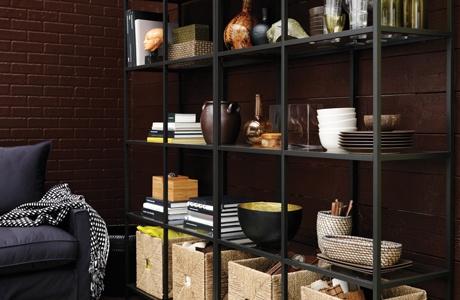Property's path of potential
A rivival in the property market thanks to government schemes such as Help to Buy could open new doors for brands, but damaged consumer trust and squeezed disposable incomes requires a fresh marketing approach.
Above: Furniture company BoConcept is tapping into the market where people can’t afford to move and so need to use the space they do have more effectively. It has seen a huge uptake of its free interior design service it launched to raise its brand profile
Signs that the property market is recovering may feel like a boon to businesses related to the sector, but brands must meet this potential mini-boom with new strategies, according to marketers from companies including Santander, retailer Furniture Village and estate agent Savills.
Mortgage lending, house prices and transactions are beginning to bounce back thanks in part to government incentives including the Help to Buy scheme[1], which means marketers will have to adapt quickly. House building was up 6 per cent in the second quarter of the year, while mortgage debt dropped by £15.4bn, according to the Bank of England. This will greatly affect industries beyond those that deal solely with the buying and selling of houses.
The £12bn Help to Buy scheme continues to be the cause of much debate both inside and outside government. Some parties expect it to fuel recovery and open up the market for first-time buyers, while others are against it, fearing it could create another pricing bubble.
Despite a Bloomberg survey of 31 economists finding that two-thirds believe it is a “bad” move, there is interest from consumers. The Royal Bank of Scotland is offering loans under the scheme and booked 5,000 mortgage appointments within three hours of the scheme being launched on 8 October; appointments doubled to 10,000 after four days – twice the number it typically expects.
Either way, there is movement in the sector so a level of adjustment is necessary in the way brands communicate with consumers.
Santander, which will begin offering mortgages under the scheme in the new year, has embarked on a big marketing push for its existing mortgage products. The ads are fronted by Formula One champion Jenson Button and their tone is very different from previous ones.
“The market has realised that price is not the be-all and end-all,” says Keith Moor, director of brand and communications. “Consumers are much more savvy. It’s a value judgement now. They understand that going with the cheapest doesn’t necessarily mean going with the best. It’s still a competitive market and you have to be priced in the game to play it but companies are increasingly realising that leading on that one dimension is not wise. Banks have a big job to do to rebuild trust and part of that is not forcing people to make big decisions based solely on price.”

This year, Ikea launched its ’Make small spaces big’ campaign in the UK and Ireland after finding that homes here are 15 per cent smaller than in Europe
Santander’s approach this time is based on insight about how consumers feel about mortgages. As they are a long-term investment, people fear it will be a noose around their neck.
“To answer that concern we have launched a range of mortgages that give people more freedom. People are free to overpay within the mortgage, but people are also free to leave whenever they want. It’s tapping into insight rather than the commoditised approach based on price,” says Moor.
Other banks are taking a similar tack. Lloyds Bank kicked off a £30m marketing campaign following its rebrand from Lloyds TSB in September, which focuses on the ‘moments that matter’. One example is an ad that tells the story of a 31-year-old man who is relieved of the frustrations of having to live with his parents after getting a mortgage through the bank. Barclays has based its proposition around listening to customers’ ideas, while TSB has relaunched with the message: ‘welcome back to local banking’.
Signs of initial recovery in the housing market have sparked renewed interest from investors too, encouraging estate agents Foxtons and Countrywide, as well as housebuilder Crest Nicholson, to float on the stock exchange. There has also been speculation that property website Zoopla is contemplating an IPO after it appointed Credit Suisse to explore “strategic opportunities”, though the Daily Mail and General Trust-owned business has downplayed such talk.
Zoopla estimates that the second phase of Help to Buy could reduce mortgage debt by £22.1bn. Its research finds there are 665,000 eligible homes on the market with an average price of £222,168. Under the mortgage guarantee scheme, the deposit needed to buy a property has dropped by two-thirds to £11,108.
As a result, property searches are going to be at an all-time high over the next year, according to the company, so it will be investing heavily to tap into consumer interest.
“First-time buyers are arguably the most important segment of the property market, as they allow those further up the chain to move, which creates supply and fluidity in the market,” says Charlotte Harper, marketing director of Zoopla Property Group. The company also owns PrimeLocation and has acquired four property portals from Trinity Mirror to compete with market leader Rightmove.
People spend more on their homes in the first 6 months than in the next 5 years so any growth in the property market is good news for us
Although the government schemes will not affect Zoopla’s marketing activity directly, says Harper, it is likely to influence some of the content it produces to ensure consumers have up-to-date information and understand the likely consequences of being involved in such a scheme (see Q&A).[2]
The company became a sponsor of Premier League team West Bromwich Albion last season, which has helped it widen its reach and profile in the UK. It also launched its largest marketing campaign to date at the beginning of September, which incorporates outdoor ads for the first
time in addition to a major TV push. The multi-million pound ‘Smart’ campaign illustrates key features of the website’s property search, such as data about proximity to local schools and transport links.
“With the property market beginning to turn, consumers are looking for guidance and information in order to help them make better property-related decisions,” she says. “Our Smart campaign seeks to own the rational side of home-buying and help people to make confident and informed choices within that process.”
While some analysts have predicted the Help to Buy mortgage guarantee initiative will lead to another property boom, specialists at Savills and Knight Frank believe that idea might be premature.
Yolande Barnes, director of residential research at Savills, said in the firm’s Q3 market analysis: “Despite all the talk of an artificially induced housing boom, resulting from Help to Buy and other government measures, this infant housing market is far from performing like the previous housing cycle did [in 2006/2007]. We are still far from a housing market boom, although the next three years may look like a mini boom in relation to the past five.”
Knight Frank associate John Waters has a similar view but nonetheless is positive about the market.
“I don’t think it is likely to cause a pricing bubble,” he says. “Central London has been quite solid for the past few years in terms of pricing, but outside of London it is a very different story. As the broader economy improves, prices will begin to rise outside of the capital a lot more than they have done for a long time. I think it will help the market to recover and it will certainly help many people outside of London that are in negative equity to get back to where they were.”

Santander will offer mortgages under the Help to Buy scheme from early next year
Lynda Clark, editor of First Time Buyer magazine, which hosts the First Time Buyer Home Show in London, confirms that consumer’s interest is on the increase as both registrations and exhibitor numbers are “markedly up”.
“Help to Buy is making the prospect of owning a home more affordable for people, even in central London where prices are much higher than elsewhere in the country. I know there’s lots of controversy about it, but anything that helps somebody buy their own home, which will be one of the biggest purchases of their life, has got to be a good thing,” she says.
An uplift in the property market will benefit home retailers too. Charlie Harrison, marketing and ecommerce director at Furniture Village, says: “We know that people spend more on their homes in the first six months [after moving in] than in the next 5 years, so any growth in the property market is good news for furniture retailers.”
He expects to see many more first-time buyers entering the market following the launch of the second stage of Help to Buy and has been scaling up accordingly.
“We have been increasing our range of fast delivery items and introduced more lines that are available to take home the same day, such as vacuum packed mattresses that fit into a car. Furniture Village offers an interest-free credit option, which is also popular with customers furnishing their first home, and we will continue to include this as a key promotional message.”
While budgets might be tight, Capital Economics property economist Matthew Pointon does expect the fortunes of home retailers to bounce back if the housing market improves.
“When the number of transactions rise you tend to get an increase in spending on things such as white goods and home improvements as people do up their homes. I’m not sure we’ve seen much evidence of that occurring just yet but it is certainly what I would expect to happen if transactions really take off,” he says.
However, he is doubtful the mortgage guarantee aspect of Help to Buy will help to fuel the industry as much as the government believes, since the monthly payments on a 95 per cent mortgage could make it more expensive than renting.
“We’re not convinced it’s going to lead to a huge increase in buyers. Even though you can get a mortgage with a 5 per cent deposit, you still need to pass strict affordability checks in order to obtain them. Concerns that there is going to be a stampede of demand are exaggerated,” he adds.
It’s incumbent on us all to be responsible in the way we lend and the conversations that we have with customers
Retailers may have another crack at the whip though, because over the past year while transactions have been down, people have turned their attention to renovating existing homes by building extensions, redecorating and generally improving their home environment.
Furniture Village, Ikea and BoConcept have all tapped into the idea of making better use of space in the realisation that not everyone has been in a position to move up the property ladder.
Harrison says: “As a result of the ‘don’t move, improve’ trend, Furniture Village has expanded its range of items that help homeowners make the most of their existing space. Products with hidden storage, such as ottoman beds, are proving popular and we have also seen an increase in sales of compact kitchen dining.”
Likewise, Ikea launched its ‘Make Small Spaces Big’ campaign in the UK and Ireland this summer after learning that homes in Britain are 15 per cent smaller than in Europe. Its global sales jumped 3.1 per cent to €27.9bn in the year to the end of August, although it does not separate UK figures.
BoConcept has seen a “huge increase” in the uptake of its free interior design service in the UK, according to country manager Zoe Shields.
“A trained member of the BoConcept sales team visits the customer’s home, measures the space and works with them to find the best possible solutions,” she says. They are then invited back to the store where they are presented with “mood boards, 3D design drawings and a set-up to reflect the products they have selected”.
As the market picks up, BoConcept will be looking to partner with local estate agents to offer the service to their clients and will also promote options such as deferred payment.
In June, B&Q launched a campaign urging homeowners to turn their attention to ‘unloved’ rooms. The retailer struggled in the early part of the year, blaming bad weather for the poor sales. But B&Q owner Kingfisher was more positive at the half-way point with a 4.3 per cent rise in group sales.

”With the property market beginning to turn, consumers are looking for guidance and information in order to help make better decisions.” - Charlotte Harper, managing director, Zoopla Property Group
Group chief executive Ian Cheshire says: “We remain ready to capitalise on any improvement in conditions or opportunities as they arise, including the potential pick-up in the UK housing market.”
However, Sainsbury’s chief executive Justin King is not so positive. He believes UK consumers are likely to have less disposable income this time next year as inflation will be around 3 per cent, while average wages will increase by 1 per cent. Despite the bleak outlook, the retailer has posted a 4.4 per cent lift in total sales for the first half of 2013.
“Although we are starting to see encouraging signs in key economic indicators, our customers’ approach to savvy shopping, which started at the beginning of the downturn, has persisted and continues,” he said in a statement.
The economic downturn has made consumers more cautious, which means companies need to be smarter in their communication.
“Whether there is a boom or not, I don’t think we will see organisations promoting in the same way,” says Santander’s Moor. “It is incumbent on us all to be responsible in the way that we lend and the conversations that we have with customers. Everyone is much more responsible than they used to be and that’s partly because consumers are more cautious but also because organisations need to address some of the concerns, fears and trust issues that people have, particularly with banks.”
References
- ^ Help to Buy scheme (www.marketingweek.co.uk)
- ^ (see Q&A). (www.marketingweek.co.uk)









